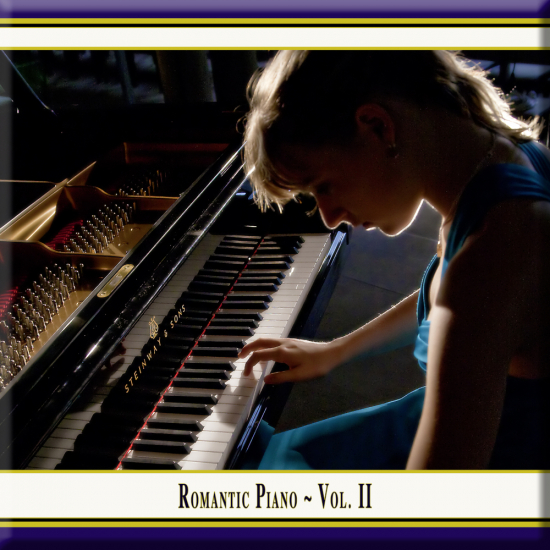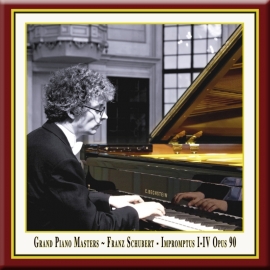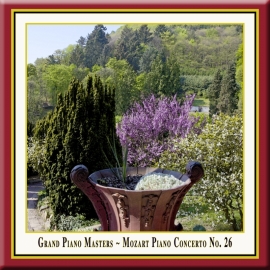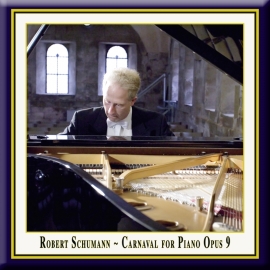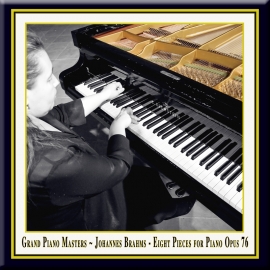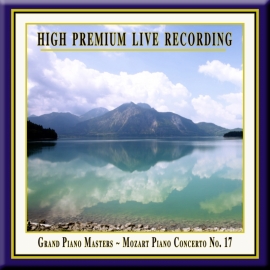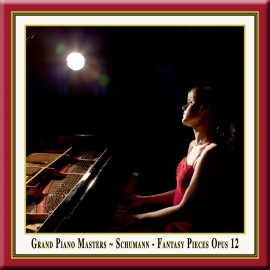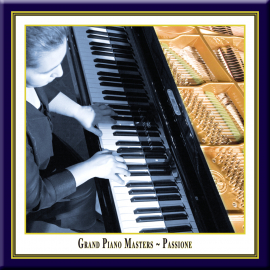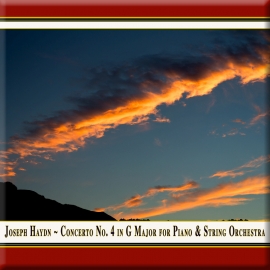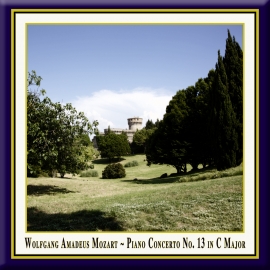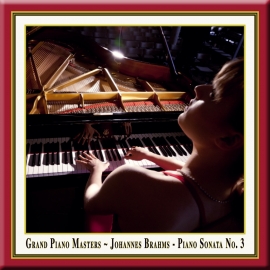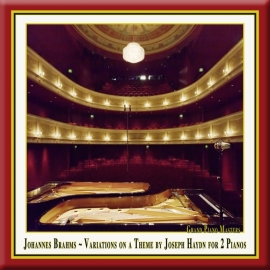Romantic Piano · Vol. 2
Romantic Piano · Vol. 2
Live recordings featuring works for Piano and Piano with Orchestra
by Schubert, Mozart, Schumann, Brahms & Haydn
HD Recording · DDD · Duration: c. 64 Minutes
12 Tracks incl. Digital Booklet


The Impromptu in G-Flat Major, Op. 90 No. 3, by Franz Schubert (1797-1828)
In 1827, a year before his death, Franz Schubert wrote the Impromptus at the age of thirty. He grouped these eight pieces into two cycles with four impromptus in each, perhaps so they could be played individually or as a whole cycle. The third Impromptu uses the Schubert "wanderer rhythm", combined with a continuous triplet movement in the melody, which is characterized this time by the falling triple. Even at this slow tempo, Schubert keeps this relentless pattern of movement going right to the end. Again, melodic phrases in the secondary voices, mainly from falling triplets - from G flat to E flat at the beginning, for example - give rise to changes in harmony that introduce a "dreamlike uncertainty" to the piece. (Franz Vorraber)
The Piano Concerto No. 26 in D Major, K. 537 "Coronation", by Wolfgang Amadeus Mozart (1756-1791)
The Piano Concerto No. 26 in D major, K. 537, was written by Wolfgang Amadeus Mozart and completed on 24 February 1788. It is generally known as "the Coronation Concerto". The concerto is scored for solo piano, one flute, 2 oboes, 2 bassoons, 2 horns, 2 trumpets, timpani (in D, A), and strings. The traditional name associated with this work is not Mozart's own, nor was the work written on the occasion for which posterity has named it. Mozart remarked in a letter to his wife in April 1789 that he had just performed this concerto at court. But the nickname "Coronation" was derived from his playing of the work at the time of the coronation of Leopold II as Holy Roman Emperor in October 1790 in Frankfurt am Main. At the same concert, Mozart also played the Piano Concerto No. 19, K. 459. (From Wikipedia, the free encyclopedia)
Carnaval for Piano, Op. 9 "Little Scenes on Four Notes", by Robert Schumann (1810-1856)
Carnaval, Op. 9, is a work by Robert Schumann for piano solo, written in 1834-1835, and subtitled "Scènes mignonnes sur quatre notes" (Little Scenes on Four Notes). It consists of 21 short pieces representing masked revelers at Carnival, a festival before Lent. Schumann gives musical expression to himself, his friends and colleagues, and characters from improvised Italian comedy (commedia dell'arte). He dedicated the work to the violinist Karol Lipinski. Carnaval had its origin in a set of variations on a "Sehnsuchtswalzer" by Franz Schubert, whose music Schumann had only discovered in 1827. The catalyst for writing the variations may have been a work for piano and orchestra by Schumann's close friend Ludwig Schuncke, a set of variations on the same Schubert theme. Schumann felt that Schuncke's heroic treatment was an inappropriate reflection of the tender nature of the Schubert piece, so he set out to approach his variations in a more intimate way, and worked on them in 1833 and 1834. The work was never completed, however, and Schuncke died in December 1834, but Schumann did re-use the opening 24 measures for the opening of Carnaval. Pianist Andreas Boyde has since reconstructed the original set of variations from Schumann's manuscript (published by Hofmeister Musikverlag), premiered this reconstruction in New York and recorded it for Athene Records... (From Wikipedia, the free encyclopedia)
The 8 Piano Pieces, Op. 76, by Johannes Brahms (1833-1897)
The 8 Piano Pieces op. 76 by Johannes Brahms comprise four Capriccios and Intermezzi each. With this collection of character pieces, published in February 1879, Brahms came forward again after a long time with a work for solo piano, which was premiered by Hans von Bülow in Berlin on October 29, 1879. While he had already composed the first Capriccio in 1871, he wrote the remaining pieces in 1878 in Pörtschach on Lake Wörth. The collection, originally divided into two booklets, shows the influence of Robert Schumann and Frédéric Chopin, whose complete editions published by Breitkopf & Härtel Brahms supervised at this time. In condensed form, the mostly three-part pieces already point to the internalized late style of Opera 116 to 119, whose characteristics include the multi-layered piano movement, chromaticism, and rhythmic refinements. The piano pieces appeared only after Brahms had not written any independent solo piano works for an extended period. After the Paganini Variations published in 1866, the Waltzes for piano four hands op. 39, which he held in high esteem, and the first part of the Hungarian Dances, initially also written for four hands, there was a long pause in publication in this field, which ended only in 1879. For Andrea Bonatta this shows how difficult it was for Brahms to find new expressive possibilities after the pianistic explorations of the virtuoso Handel and Paganini Variations. For the pianist, chamber musician and gifted sight-reading player, this phase did not mean that he would have completely abandoned the piano. In addition to the Waltzes and Hungarian Dances, he wrote the Sonata for Piano and Violoncello op 38, the Liebeslieder Waltzes op 52, the version for two pianos of his Haydn Variations op 56b, the Piano Quartet No. 3 in C minor op 60 and the Neue Liebeslieder op 65 during this period. In 1878, he also began to work on his symphonic Second Piano Concerto in B flat major; the piano thus played an important role in chamber and later concertante music. (From Wikipedia, the free encyclopedia - Translated with www.DeepL.com/Translator)
The Piano Concerto No. 17 in G Major, K. 453, by Wolfgang Amadeus Mozart (1756-1791)
The Piano Concerto No. 17 in G major, KV. 453, by Wolfgang Amadeus Mozart, was written in 1784. The work is orchestrated for solo piano, flute, two oboes, two bassoons, two horns, and strings. As is typical with concerti, it is in three movements: Allegro, Andante and Allegretto - Presto. According to the date that the composer himself noted on the score, the concerto was completed on April 12, 1784. The date of the premiere is uncertain. In one view, the work is said to have been premiered by Mozart's student Barbara Ployer on June 13, 1784, at a concert to which Mozart had invited Giovanni Paisiello to hear both her and his new compositions, including also his recently written Quintet in E flat for Piano and Winds. Afterwards, Ployer was joined by Mozart in a performance of the Sonata for Two Pianos, K. 448. Another possibility, advanced by Lorenz, is that Mozart did not wait over two months to premiere the work, but performed it in his concert with Regina Strinasacchi on 29 April 1784 at the Kärntnertortheater. As a general consensus for researchers, it can be said with relative certainty that the work premiered during the mid-to-late spring of 1784, following its completion. (From Wikipedia, the free encyclopedia)
The Fantasy Pieces for Piano, Op. 12, by Robert Schumann (1810-1856)
A creation of significance for the compositions of the romantic era: the cycle "Fantasy Pieces" for Piano Opus 12 by Robert Schumann. Inspired by a collection of novellas by E.T.A. Hoffmann, called "Fantasiestücke in Callots Manier", it seems that Schumann had the characters "Florestan" and "Eusebius" in mind - two characters he created for representing the duality of his personality: Eusebius depicts the dreamer and Florestan represents Schumann's passionate side. The virtual dialogue between both characters during the movements ends in the piece "End of the Song", which Schumann has described in a letter to his wife Clara: "Well in the end it all resolves itself into a wedding...".
The 3 Intermezzi, Op. 117, by Johannes Brahms (1833-1897)
The Three Intermezzi for piano, Op. 117, are compositions that Johannes Brahms created for solo piano. The intermezzi were described by the critic Eduard Hanslick as "monologues"... pieces of a "thoroughly personal and subjective character" striking a "pensive, graceful, dreamy, resigned, and elegiac note". The Intermezzi of Opus 117 were composed in 1892. The first intermezzo in E-flat major is prefaced in the score by two lines from an old Scottish ballad "Lady Anne Bothwell's Lament": "Balow, my babe, lie still and sleep! - It grieves me sore to see thee weep."... (From Wikipedia, the free encyclopedia)
The Piano Concerto No. 4 in G Major, Hob. XVIII:4, by Joseph Haydn (1732-1809)
Papa Haydn - nothing of the sort! The great musician always knew how to entertain people without using cheep templates filled with gaudy timbres or highly dramatic gestures. For him, joie de vivre is admissible, even desirable. Behind this rhythmic vitality and all the gestures, the master distinguishes and seduces people to superior thoughts, too. Little is known about the creation of the piano concert in G major. Guaranteed is just a date of performance on April 28th, 1784 at the Concert spirituel in Paris with the blind Viennese pianist Maria Theresia Paradis, whom i. a. Mozart composed for. The importance of Haydn as author of concertos is still underestimated in the History of Music. This particular concerto is composed for a string quartet only, without blowers. It comprises a typical, classically built work full of surprises and embellishments. This extent of humor and playfulness will rarely be accomplished by composers later born. (Franz Vorraber)
"The concertos are just the medium between being too heavy and too light - they are very brilliant - pleasant to hear - certainly without falling into the void - here and there it is possible for the connoisseur alone to get satisfaction - but such - that the laymen can be contented without knowing why." (Wolfgang Amadeus Mozart about the three concertos for piano K. 413, K. 414 and K. 415 in a letter to his father on December 28th, 1782). Having provided us with magnificent examples of concertos for stringed and wind instruments, Mozart reaches the ideal conception of a concerto with his piano concertos. They are the high point and peak of his instrumental producing. In Mozart's piano concertos two equal forces are facing each other that are really able to compete. They are therefore essentially his very unique creation. The piano concertos K. 413 - 415 and K. 449 were the first in a row of 17 momentous concertos created in Vienna and consequently founding his fame as virtuoso to the Viennese audience. The double possibility given to the performance, of either playing full orchestra, with oboe and horn (in the C-Major also with timpani and trumpet) or just with string quartet shows the flexibility he wanted to produce. The concerto in C-major K. 415 is the most splendid one. The second movement Mozart first planned in c-minor, but he gave up this intention in favor of a light, jaunty movement in F-major. Nevertheless, there is a slight reminiscence to this original minor movement in the concerto's last movement: the vivid six-quaver beat with his appeal to the Papageno-motif is interrupted two times by a melancholic insertion in c-minor. The concerto in E-flat-major K. 449 is the first composition registered by Mozart in his own catalogue of works that he started in February 1784. It belongs to the most accomplished works of Mozart's music, with his latent, but dramatic dynamic and its depth that goes beyond the diverging antagonism of musical forces. The piano concertos of Mozart never seem to touch the border of the socially appropriate - how could it, being designed to be acclaimed. But even so, it opens the doors to tell about the dark and the bright, the serious and the cheerful, the deepest - to lead its audience to a higher level of knowledge. The audience that is to deal with Mozart's piano concertos is the best there is. (Christoph Soldan)
The Piano Sonata No. 3 in F Minor, Op. 5, by Johannes Brahms (1833-1897)
Through evening's shade, the pale moon gleams - While rapt in love's ecstatic dreams - Two hearts are fondly beating", quoted Johannes Brahms above the notes for the "Andante" in the Piano Sonata No.3. This excerpt of a poem by C.O. Sternau (a pseudonym of Otto Inkermann) characterizes the mood of this piece, which had a large contribution to the fame of the young composer. Written in 1853 this "poetic" sonata marks the end of a cycle of three sonatas. Likewise it was the last tune the 20-year-old composer submitted to Robert Schumann for commentary. Robert Schumann himself described Brahms in an article titled "Neue Bahnen" (New Paths) in October 1853 as "a man with a calling" who was "destined to give ideal expression to the times".
The Variations on a Theme by Joseph Haydn (German: Variationen über ein Thema von Jos. Haydn), now also called "The Saint Anthony Variations", is a work in the form of a theme and variations, composed by Johannes Brahms in the summer of 1873 at Tutzing in Bavaria. It consists of a theme in B-flat major based on a "Chorale St Antoni", eight variations, and a finale. The work was published in two versions: for two pianos, written first but designated Op. 56b; and for orchestra, designated Op. 56a. The orchestral version is better known and much more often heard than the two-piano version. It is often said to be the first independent set of variations for orchestra in the history of music, although there is at least one earlier piece in the same form, Antonio Salieri's Twenty-six Variations on 'La folia di Spagna' written in 1815. Brahms's orchestral variations are scored for piccolo, 2 flutes, 2 oboes, 2 clarinets, 2 bassoons, contrabassoon, 4 horns (2 in E flat, 2 in B flat), 2 trumpets, timpani, triangle, and the normal string section of first and second violins, violas, cellos and double basses. The piece usually takes about 18 minutes to perform. The first performance of the orchestral version was given on 2 November 1873 by the Vienna Philharmonic Orchestra under Brahms's baton... (From Wikipedia, the free encyclopedia)
P
ublishing Authentic Classical Concerts entails for us capturing and recording outstanding performances and concerts for posterity. The performers, audience, opus and room enter into an intimate dialogue that in its form and expression, its atmosphere, is unique and unrepeatable. It is our aim, the philosophy of our house, to enable the listener to acutely experience every facet of this symbiosis, the intensity of the performance, so we record the concerts in direct 2-Track Stereo digital HD. The results are unparalleled interpretations of musical and literary works, simply - audiophile snapshots of permanent value. Flourishing culture, enthralling the audience and last but not least also you the listener, are the values we endeavor to document in our editions and series.
The concert grand piano is incontestably the king of instruments. We could now wax lyrical about its incomparable dynamics and go into its ability to go from the tenderest of sounds in a soft minor key to the magnificent power of a fortissimo, or I could rhapsodise about its impressive size and elegance. But what makes this instrument really fascinating is its individuality, since each one is unique in itself - created by a master. A concert grand has a life all of its own that a virtuoso can really "get into" and hence bring the work of the composer to life. In our Grand Piano Masters Series, we get into the character and soul of the concert grand piano and experience, during the performance itself, the dialogue between the instrument, the virtuoso and the performance space.
Andreas Otto Grimminger & Josef-Stefan Kindler, K&K Verlagsanstalt
Franz Schubert (1797-1828):
4 Impromptus, Op. 90, D. 899
1. Impromptu in G-Flat Major, Op. 90, No. 3 (6:54)
Performed by Franz Vorraber (Piano)
Wolfgang Amadeus Mozart (1756-1791):
Piano Concerto No. 26 in D Major, K. 537
"Coronation"
2. II. Larghetto (6:29)
Performed by Christoph Soldan (Piano)
and the Silesian Chamber Orchestra,
conducted by Pawel Przytocki
Robert Schumann (1810-1856):
Carnaval for Piano, Op. 9
"Little Scenes on Four Notes"
3. XII. Chopin. Agitato (1:16)
Performed by Rolf Plagge (Piano)
Johannes Brahms (1833-1897):
8 Piano Pieces, Op. 76
4. No. 7: Intermezzo in A Minor (3:36)
Performed by Lilya Zilberstein (Piano)
Wolfgang Amadeus Mozart (1756-1791):
Piano Concerto No. 17 in G Major, K. 453
5. II. Andante (9:11)
Performed by Christoph Soldan (Piano)
and the Cappella Istropolitana,
conducted by Pawel Przytocki
Robert Schumann (1810-1856):
Fantasy Pieces for Piano, Op. 12
6. No.1: Des Abends. Sehr innig zu spielen (3:59)
Performed by Magdalena Müllerperth (Piano)
Johannes Brahms (1833-1897):
3 Intermezzos, Op. 117
7. No. 1 in E-Flat Major (5:13)
Performed by Lilya Zilberstein (Piano)
Franz Joseph Haydn (1732-1809):
Concerto No. 4 in G Major for Piano & String Orchestra, Hob. XVIII:4
8. II. Adagio (6:35)
Performed by Franz Vorraber (Piano & Conducting)
and the Castle Concerts Orchestra
Wolfgang Amadeus Mozart (1756-1791):
Piano Concerto No. 13 in C Major, K. 415
Version for Piano & String Quintet
9. II. Andante (6:21)
Performed by Christoph Soldan (Piano)
and the Silesian Chamber Soloists
Johannes Brahms (1833-1897):
Piano Sonata No. 3 in F Minor, Op. 5
10. II. Andante espressivo (9:49)
Performed by Magdalena Müllerperth (Piano)
Robert Schumann (1810-1856):
Carnaval for Piano, Op. 9
"Little Scenes on Four Notes"
11. XIV. Reconnaissance. Animato (1:41)
Performed by Rolf Plagge (Piano)
Johannes Brahms (1833-1897):
Variations on a Theme by Haydn, Op. 56b
"Saint Anthony Variations"
Version for 2 Pianos
12. Variation 7: Grazioso (2:31)
Performed by Rolf Plagge & Wolfgang Manz (Piano)
"Duo Reine Elisabeth"
Sound & Recording Engineer: Andreas Otto Grimminger
Production & Mastering: Andreas Otto Grimminger & Josef-Stefan Kindler
Photography, Artwork & Coverdesign: Josef-Stefan Kindler

